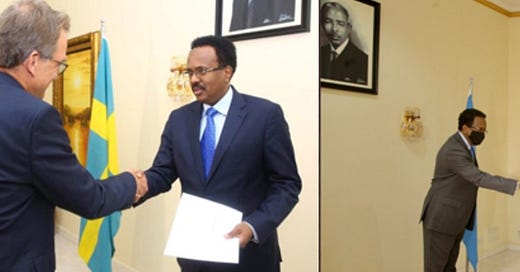Different perspectives on Somalia. Part XII.
Ambassadorial nomination to Somalia and Presentation of credentials
Once we used to have diplomatic warriors…. This is Part XII of the reflections of a former diplomat and a friend of mine who after many years decided to share with me some of the interesting experiences he encountered while working for the Somali Foreign Affairs Ministry (FAM) and during his diplomatic career.
When Mr. Hussein M. Mohamed was the protocol officer at the FAM in Somalia from 1982 onwards, there used to be a formal procedure that was followed to receive new Ambassadors into Somalia. When a country decides to send an ambassador to Somalia, the initial step is to officially communicate with the Somali FAM about its intention for that nomination. If that country maintains an Embassy in Mogadishu, then its Embassy will act on their behalf to forward the nomination by means of a note verbale along with the curriculum vitae of the nominated person. Otherwise, that country will use its non-resident Embassy to Somalia for that purpose.
The FAM will then send the nomination to the Somali Cabinet, who will after discussion normally consent to the proposed nomination. On very rare occasions will the cabinet decide otherwise, and if that ever occurs, the government will not respond and will remain silent on the issue. So under normal circumstances, the FAM will respond back to the concerned country to inform the affirmative notification of Somalia to its ambassadorial nomination. After arrival, the Ambassador-designate will first call upon the Chief of Protocol to get to know each other. On his second visit to either the Minister or Minister of State whichever is available, he would have the opportunity to hand over the un-sealed copy of his credential letter.
Then on the appointed date for presenting the original letter, a protocol officer will take two official cars to either the residence or the Chancery of the new Ambassador whichever they choose. Usually, the new Ambassador’s party should not exceed four including the Ambassador. The new Ambassador will ride in the back seat on the right-hand side of the first car with the accompanying Protocol officer sitting beside him, while the other party will take the second car. Police motorcycles will lead the way to the Presidential palace and only the Somali flag will fly the car on its first journey to the Presidency.
Arriving at the arena of the Presidency, the Chief of Protocol would greet the new ambassador as he gets out of the car and stand together to take a salute from a military commander. Then together they walk on a laid carpet inspecting the troops. The photographer will be taking shots during the troop inspection. After that, the whole party would be ushered inside a very big hall. The President, Foreign Minister or Minister of State – whichever is available, Director of Foreign Relation Office of the Presidency and the President’s military escort on one side, and the party who just entered on the other side. The Chief of Protocol will guide the new Ambassador and the accompanying diplomats to stand right in front of the President where the ceremony begins, me standing behind Chief of Protocol.
The Ambassador-designate will speak, saying in essence that he was glad to represent his country in this capacity and would spare no effort in strengthening the relations of the two countries, adding he wants to present credentials accrediting him as Ambassador of so and so. He would hand over the sealed credence letter first, and would next greet the President, then the Foreign Minister & the Director. Then he would introduce his accompanying colleagues according to their ranks. Of course, the official photographer will be busy taking shots at these moments.
The President would privately invite the new Ambassador to sit down and have coffee, drinks, etc, expressing how delighted he was to receive and accept his credentials, adding the government will accommodate and was looking forward to furthering the existing relations of the two nations. Usually, if the accompanying diplomats are three or four, then they would wait with the protocol officer in the adjoining reception room. The Chief of Protocol would finally guide the Ambassador to sign the visitor’s book, with the accompanying diplomats standing behind their Ambassador, presenting another photo opportunity for the photographer.
On the way back, the Chief of Protocol would sit beside the Ambassador and the Protocol officer would sit in the passenger seat of the first official car, flying this time the Somali flag and the flag of the country the Ambassador represents, signifying from that moment onwards that Ambassador was officially accredited, and can begin his official duties. The new Ambassador may in some cases invite the Chief of Protocol and the officer for a light snack - biscuits and pastries, concluding the ceremony.
Hussein M Mohamed and I went to Casa Popolare Primary School, Hodan, Mogadishu in the 1970s. And later on, we were the first and second students who were admitted to the faculty of Journalism where he graduated and joined the Somali FAM. He continued to serve the country as a diplomat, but I left and continued my studies at Monash University in Australia and may rapidly add not on a Somali government scholarship! We are now working on a book about Somali Foreign Affairs, stay tuned.
Hussein M Mohamed can be contacted via hmm@somaliaaway.com





Interesting read!
Very insightful